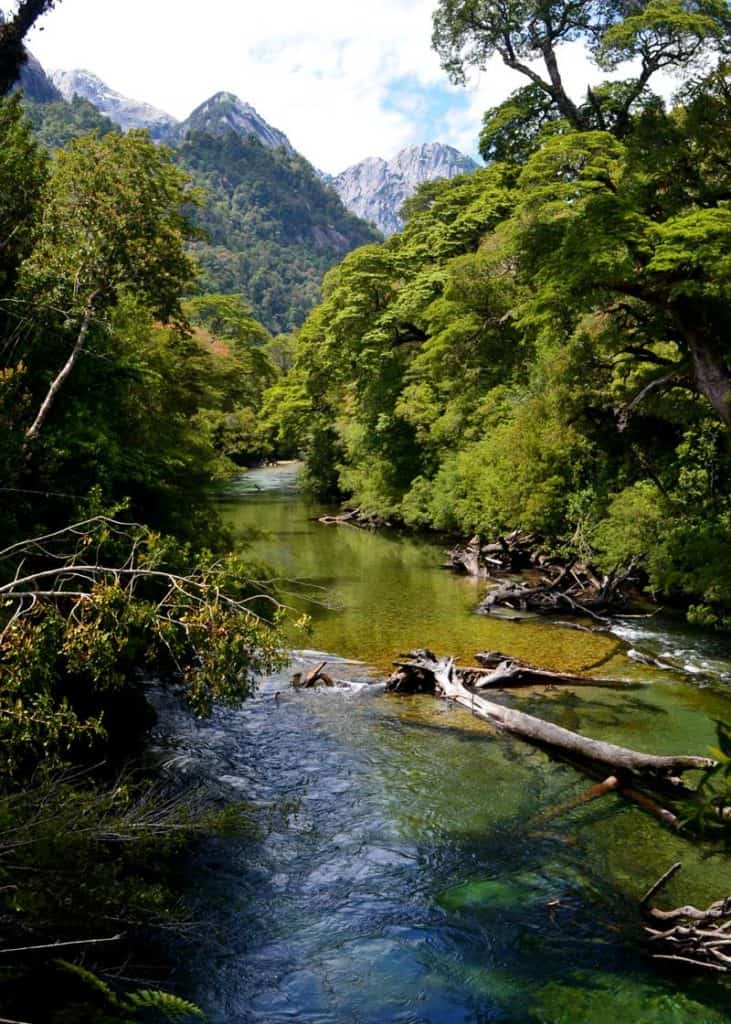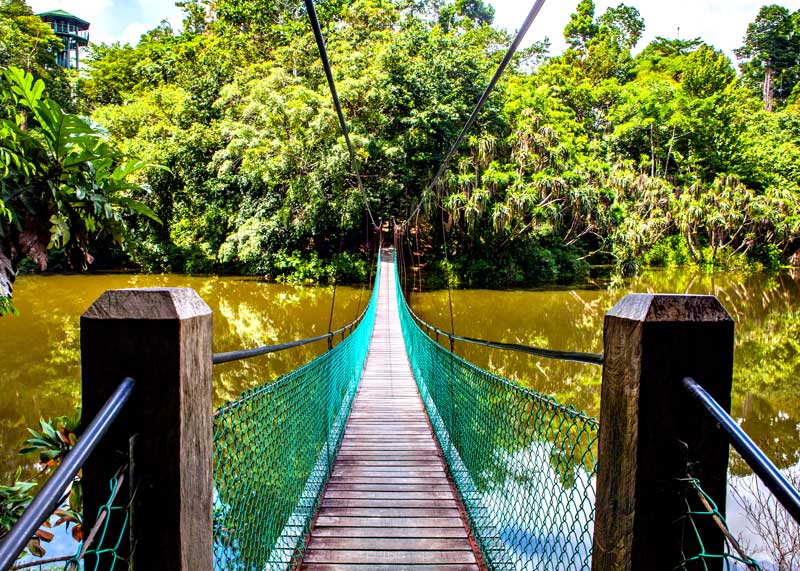16 Largest Rainforests in the World: Travelers Guide
When I was in grade 2 my teacher taught us all about rainforests. I’ve been fascinated by them ever since. If you’re like me, you’ll enjoy learning all about the 16 largest rainforests in the world. To start off with, we’ll look at the largest rainforest in the world. And then examine what exactly a rainforest is.

What is the Largest Rainforest in the World?
The world’s largest rainforest is the Amazon Jungle! This massive rainforest covers 1.4 billion acres (5,500,000 square kilometers). At the heart of Amazonia is the Amazon River, the largest river in the world.
The Amazon is roughly the same size as all of the other tropical rainforests combined. It is estimated to contain over 3 million species of living things, many of which are yet to be discovered. That makes it the most biologically diverse place on earth.
Some of the animal species here are jaguars, sloths, monkeys, poison dart frogs, harpy eagles, and pink river dolphins.
A more recent discovery is a monkey that purrs like a cat.
Before we get to the full list, here’s a quick breakdown of the types of rainforest.
What is a Rainforest?
According to Collins English Dictionary, “A rainforest is a thick forest of tall trees which is found in tropical areas where there is a lot of rain.”
But did you know that there are actually two types of rainforests?
- Temperate Rainforests can be located at quite a distance north or south of the equator. As such, they experience changes in the season, including some colder weather. The thing that makes them a rainforest is, you guessed it, lots of rain. Temperate rainforests can be found as far north as Alaska. The average rainfall for this type of forest is around 55 inches (1400 millimeters).
- Tropical Rainforests are what we usually picture when thinking of rainforests. These jungles are generally hot and humid. There are actually two types of tropical wet forests, with things such as latitude and altitude play a part.
2 Types of Tropical Rainforests
- The first type is Equatorial Rainforests, also called “lowland equatorial evergreen forests.” These forests are usually found 10 degrees north and south of the equator. Because of their location, they do not have a variation in seasons, and receive regular rainfall throughout the year. They are considered “true” or “real” rainforests in the purest sense of the word. Rainfall in these parts is around 80 inches (roughly 2030 millimeters) a year.
- The second type is Moist Forests. Further subcategories here include Cloud Forests (also know as montane forests). These forests are at a higher altitude and get a lot of their moisture from mist and fog as opposed to rainfall. The trees are a little shorter than they are at lower altitudes, but full of epiphytes like orchids. Accumulated moisture here is up to 79 inches (2000 millimeters) a year.
Another subcategory of moist forests is the Seasonal Tropical Forest. They still get lots of rain, but it tends to come all at once, like in a Monsoon Rainforest. Annual rainfall here is about 55 inches (1400 millimeters) but may go up to 320 inches (8130 millimeters) in a particularly wet year.
As different organizations and different countries vary in their definition of what constitutes a rainforest, the list below contains a mix of the different types of rainforests.
See this NASA chart (temperature, precipitation) for Manaus, Brazil in the Amazon.
Learn more about cloud forests in Ecuador.
Guide to the 16 Largest Rainforests in the World
1. The Amazon
- Type: Tropical
- Size: 1.4 billion acres (5,500,000 square kilometers)
- Continent: South America
- Countries: Bolivia, Brazil, Colombia, Ecuador, French Guiana, Guyana, Peru, Suriname, and Venezuela

The Amazon rainforest is spread across 9 countries and 3,344 indigenous territories. Of the 350 ethnic groups in the Amazon, 60 of them remain isolated.
The Amazon is home to incredible wildlife, including pygmy marmoset, spectacled and black caiman, vampire bats, and even vampire fish.
You can also see snakes, like Bothrops asper and the emerald tree boa.
One of the most popular national parks in Ecuador is Yasuni National Park – one of the most biodiverse places on earth.
The Amazon River is the longest river in South America.
2. Congo Rainforest
- Type: Tropical
- Size: 440 million acres (1,780,000 square kilometers)
- Continent: Africa
- Countries: Cameroon, Central African Republic, Democratic Republic of the Congo, Republic of the Congo, Equatorial Guinea, and Gabon

Just as the Amazon Rainforest surrounds the Amazon River, the Congo River serpentines its way through the Congo Rainforest.
The Congo River is the second-longest river in Africa.
Mountain gorillas, forest elephants, chimpanzees, bonobos, and buffalo all call this area home.
In total, there are around 10,000 species of tropical plants in the Congo Basin, 400 species of mammals, 1,000 species of birds, and 700 species of fish.
3. New Guinea Rainforest
- Type: Tropical
- Size: 71 million acres (288,000 square kilometers)
- Continent: Oceania
- Countries: Indonesia, and Papua New Guinea

Shared by 2 countries (Indonesian provinces to the west and Papua New Guinea to the east), the rainforest on the island of New Guinea is home to more orchid species than any other place on earth.
It also is home to some very unique wildlife, like rats that are bigger than most house-cats (Bosavi Woolly Rat), and kangaroos with the ability to climb trees.
4. Valdivian Rainforest
- Type: Temperate
- Size: 61 million acres (248,100 square kilometers)
- Continent: South America
- Countries: Argentina and Chile

The Valdivian Rainforest covers a narrow strip of land between the Andes Mountains and the Pacific Ocean in Argentina and Chile. It’s quite often foggy here, and much colder than you would expect.
Summertime highs reach around 62°F (16.5°C) and drop to 45°F (7°C) during the colder months.
Some of the unique mammals here are the southern pudú (the world’s smallest deer), the monito del monte (an adorable tree-dwelling marsupial), and the kodkod (a wild cat that looks like a leopard but is the size of a house-cat).
5. Eastern Australian Temperate Forests
- Type: Temperate
- Size: 55 million acres (222,100 square kilometers)
- Continent: Oceania
- Countries: Australia
This area of forest stretches along the east coast of Australia from New South Wales to southern Queensland.
There are several different habitat types here including eucalyptus woodlands, dry forests, and patches of rainforests.
6. Heart of Borneo
- Type: Tropical
- Size: 54 million acres (220,000 square kilometers)
- Continent: Asia
- Countries: Brunei, Indonesia, and Malaysia

Borneo is the third-largest island in the world (not including Australia). There is a conservation agreement in place here through the WWF, to protect Asia’s “Last Great Rainforest,” as half of the forest has already disappeared.
There’s a huge amount of biodiversity here including tigers, rhinos, elephants, sun bears, and clouded leopards.
7. Luzon Rain Forests
- Type: Tropical
- Size: 27 million acres (109,965 square kilometers)
- Continent: Asia
- Countries: Philippines

Luzon is the largest island in the Philippines. The rainforest here is a mix of lowland rainforest, and montane forest (which is found on volcanic and non-volcanic mountains).
There are at least 31 mammal species on Luzon that are found nowhere else in the world.
8. Pacific Temperate Rainforest
- Type: Temperate
- Size: 15 million acres (60,346 square kilometers)
- Continent: North America
- Countries: Canada, and the USA

This temperate rainforest stretches in a narrow corridor along 2,500 miles (4023 kilometers) of the Pacific coast of North America.
On the south, it begins with the redwood forests in Northern California. Proceeding north, it continues through Oregon, Washington, British Columbia, and terminates in Southern Alaska. At its widest, it is 93 miles (150 kilometers) wide, as it relies on the ocean to produce its characteristic rain.
Significant National Parks within this range include Tongass National Forest (Alaska), Great Bear Rainforest (British Columbia), Pacific Rim National Park (Vancouver Island, BC), Olympic National Park (Washington), Hoh Rain Forest (Washington), Valley of the Giants (Oregon), and Redwood National Park (California).
9. Cardamom Mountains Rain Forests
- Type: Tropical
- Size: 10 million acres (44,288 square kilometers)
- Continent: Asia
- Countries: Cambodia, Thailand, and the Vietnamese island of Dao Phu Quoc
The Cardamom Mountains Rain Forests are hard to access due to their remote location, difficult terrain, and very small human population. As such, they remain relatively unexplored.
The region is home to the banteng (a type of cow), gaur (also known as the Indian bison), dhole (a wild dog), gibbons, elephants, leopards, and many others.
10. Queensland Tropical Rain Forests
- Type: Tropical
- Size: 8 million acres (32,700 square kilometers)
- Continent: Oceania
- Countries: Australia

This area of forest can be found along the north-eastern coast of Australia.
Highlights of the area include the Skyrail Rainforest Cableway, which runs for 4.7 miles (7.5 kilometers) over Barron Gorge National Park, and the Daintree Rainforest Park (which combines tropical rainforest with white sandy beaches).
11. Costa Rican Rainforests
- Type: Tropical
- Size: 6.4 million acres (26,050 square kilometers)
- Continent: North (Central) America
- Countries: Costa Rica
51% of Costa Rica is rainforest. It’s known for its rainforest tourism and features a wide range of accessible and less-accessible parks.
If you’d like to try zip-lining or rafting through the jungle, Costa Rica is the place to be.
Keep your eyes open for monkeys, sloths, toucans, and big cats. Visit one of Costa Rica’s 28 National Parks, such as Monteverde Cloud Forest Reserve, Corcovado National Park, or Tortuguero National Park.
Other Rainforests of Interest:
| Name | Type | Size | Continent | Countries | |
| 12 | Tropical Rainforest Heritage of Sumatra | Tropical | 6.2 million acres (25,000 km²) | Asia | Indonesia |
| 13 | Bosawás Biosphere Reserve | Tropical | 4.9 million acres (20,000 km²) | North (Central) America | Nicaragua |
| 14 | Lacandon Jungle | Tropical | 4.7 million acres (19,000 km²) | North America | Mexico |
| 15 | Sri Lanka Lowland Rain Forests | Tropical | 3.1 million acres (12,493 km²) | Asia | Sri Lanka |
| 16 | Westland Temperate Rainforest | Temperate | 2.9 million acres (11,880 km²) | Oceania | New Zealand |

Keep reading: Lake Maracaibo: The Lightning Capital of the World
Your Turn:
So now that you’ve seen the list, where do you want to go? Is there a rainforest that you think should be added to this list? Join the discussion in the comments below.






